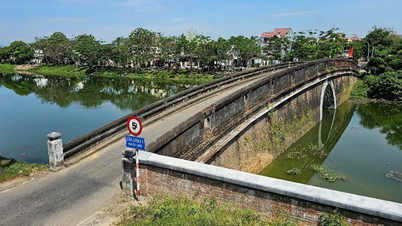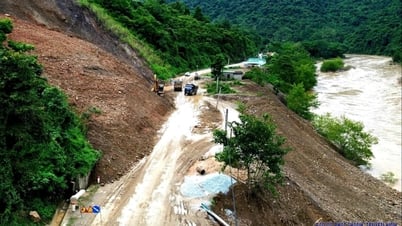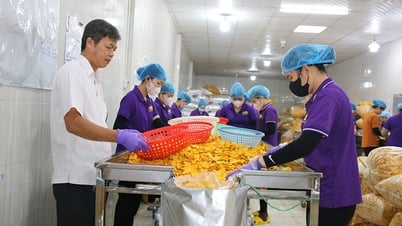With a coastline of about 3,260 km and high thermal radiation, salt is an indispensable commodity for social and human life. Salt is not only used for eating and in the food processing industry, but also in the medical field, in the chemical industry and some other industries. Salt production, processing and consumption is an economic sector that is creating jobs and income for about 21,000 salt farmers, contributing to maintaining security, order and rural society in coastal areas of Vietnam.
According to the Department of Economic Cooperation and Rural Development, Ministry of Agriculture and Rural Development (MARD), salt production in Vietnam is a traditional, long-standing profession, a production sector of great importance to the economic development of the country. In the 50s and 60s of the last century, salt was of great importance to the national economy, attracting and creating jobs for hundreds of thousands of salt workers.
On May 23, 1955, the Prime Minister issued Decree No. 535/TTg, establishing the Salt Department under the Ministry of Finance to manage and develop salt production and in socio-economic statistics, the salt industry (including production and distribution) became an independent national economic sector. Since then, the Government has issued support policies, ministries, branches and localities have issued many guidelines for organizing and implementing the development of the salt industry to support the livelihoods and incomes of tens of thousands of salt farmers (most of whom are poor and low-income households).
According to statistics, there are currently about 10,883 salt-producing households nationwide. Salt-producing households produce salt under the direct guidance of the agricultural committees of local communes and towns. Salt-producing workers are mainly manual laborers, mostly the elderly, women and children. Salt-producing farmers collect salt and put it in piles on the banks of the fields, which are roughly covered, and then sell it to traders or to local salt processing facilities.
Data reported from localities shows that there are currently no salt farms nationwide according to Circular No. 02/2020/TT-BNNPTNT dated February 28, 2020 of the Ministry of Agriculture and Rural Development stipulating farm economic criteria; there are only 2 salt cooperative groups in Hai Dong commune, Nam Dinh province and Tri Hai commune, Ninh Thuan province; there are 37 salt cooperatives in 15 provinces and cities.
According to the report of the Department of Economic Cooperation and Rural Development, although Vietnam is a potential salt producing country, every year Vietnam has to import from 400,000 to 600,000 tons of salt to meet domestic demand. Domestic salt has low value, and there is a lot of inventory. Many salt farmers have quit their jobs and switched to other jobs, and salt businesses are struggling to find a way to survive. In addition, there is strong competition from imported salt, especially from India and China.
Salt production areas across the country have been formed for a long time and are spontaneous, small-scale, and scattered. The infrastructure of salt fields has not been invested in upgrading or repairing regularly for a long time, so the infrastructure serving salt production of salt farmers in most localities is currently very weak, causing low salt productivity and many difficulties for salt farmers: Canals supplying and draining water for salt fields have been seriously degraded and are mostly shared with other fields such as agriculture, aquaculture, etc. In particular, some localities have to use groundwater (Ninh Thuan, Khanh Hoa) to make salt. The number of salt fields produced on an industrial scale is still small compared to demand. Some scientific advances have been applied but are not synchronous, so they have not been effective. The country has 73 salt production and processing establishments belonging to all economic sectors such as production and business households, cooperatives, and enterprises. However, these units are all small-scale, have low charter capital, small output, and outdated equipment and technology.
Furthermore, salt production is still mainly done by manual methods, with a dispersed scale according to salt farmers (accounting for 69% of the area), so the productivity and quality of industrial salt fields have not met the requirements of the chemical industry, so industrial salt must still be imported, the amount of salt from industrial salt fields is mainly used to process refined salt to supply salt for the food processing industry, so it competes directly with salt produced by salt farmers. Some salt production areas of our country in the South Central provinces (Khanh Hoa, Ninh Thuan, Binh Thuan) have very favorable natural conditions for the development of industrial-scale salt production but have not received much attention for investment and development. In Northern Vietnam, there are many areas that produce salt products with low NaCl content (light salt), containing dozens of trace elements that are very good for health and beauty. This product is of interest to many countries and there is a need to import it in large quantities, but the salt output is not much and the salt quality is low (with many impurities), so it cannot meet the quantity and quality requirements for import.
Notably, life is difficult, the salt industry's economy is unstable, people's income is very low, most of the salt producers are poor households, without capital to invest. They have not been trained and equipped with knowledge about salt production techniques, so the application of technical advances in salt production is limited. The purchase and sale of salt has not been linked in the value chain between salt processing enterprises with cooperatives, cooperative groups and salt farmers to stabilize salt production, processing and consumption. The salt market has almost no brand promotion, geographical indications, so there have not been strong brands that are dominant and leading...
In fact, the characteristics of salt making depend heavily on natural weather conditions, so climate change has clearly affected salt production. In recent years, there have been frequent unseasonal rains that have caused great damage to salt production, leading to a decrease in salt productivity. Currently, only a few large production enterprises in the country have warehouse systems to store goods, so they can proactively source goods and stabilize prices. Most salt households and cooperatives do not have warehouses or are very fragmented, so during the main season, they can sell at low prices, but after the season, there is no more goods to sell, leading to unstable efficiency and income for salt farmers. Lending capital to salt households to invest in salt production is also difficult to implement, because income from salt production is low, so many households have difficulty repaying bank loans on time. Authorities at all levels have not really paid attention to supporting the development of the domestic salt industry. Salt production infrastructure is broken and degraded; Land planned for salt production is encroached upon and converted to other uses (aquaculture). Although it is defined as an essential product, the state-invested distribution business model no longer exists.../.
Source link

























































































![[OCOP REVIEW] Bay Quyen sticky rice cake: A hometown specialty that has reached new heights thanks to its brand reputation](https://vphoto.vietnam.vn/thumb/402x226/vietnam/resource/IMAGE/2025/7/3/1a7e35c028bf46199ee1ec6b3ba0069e)










Comment (0)